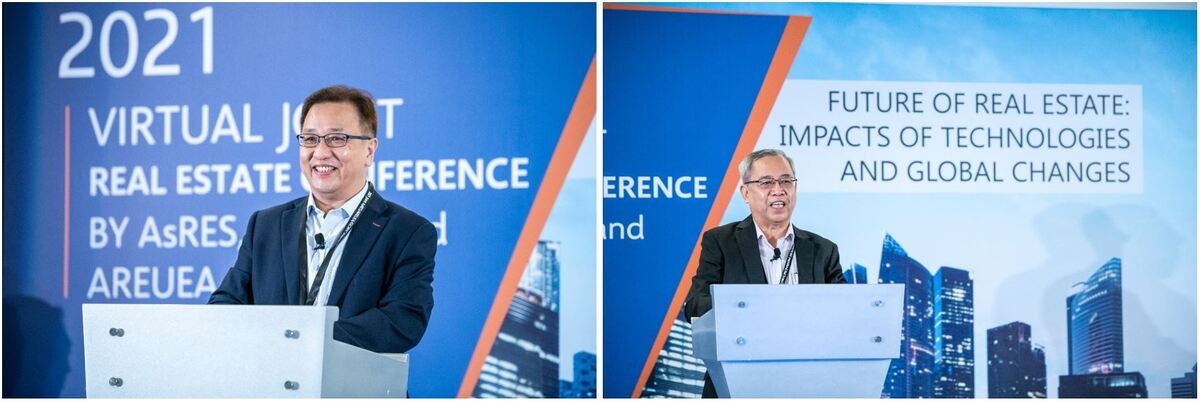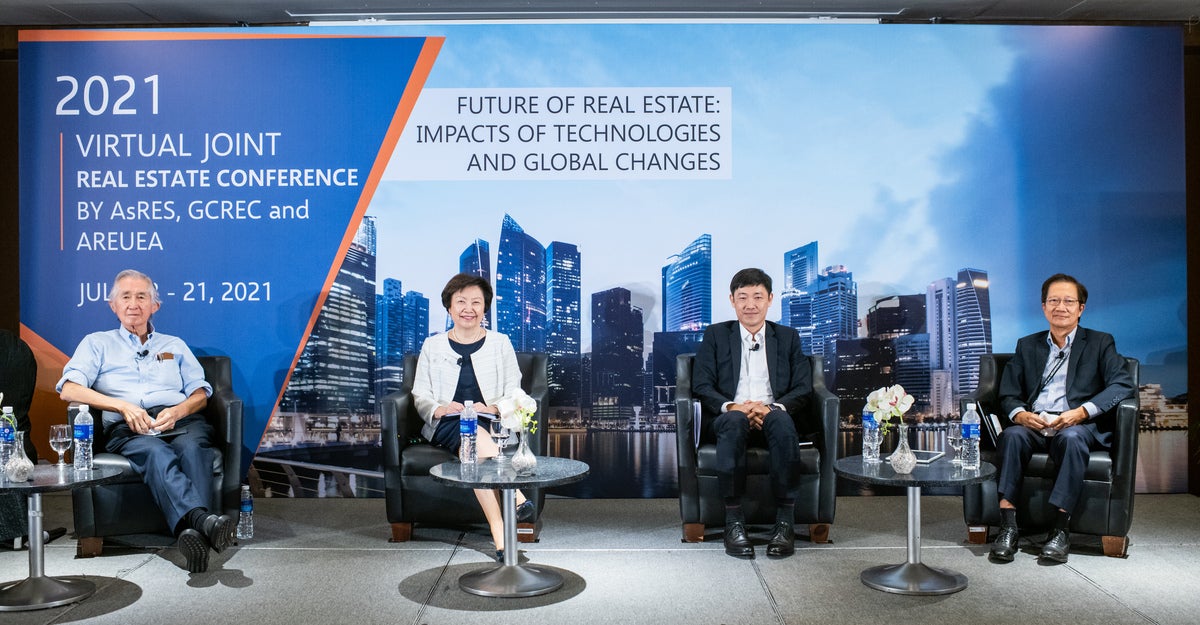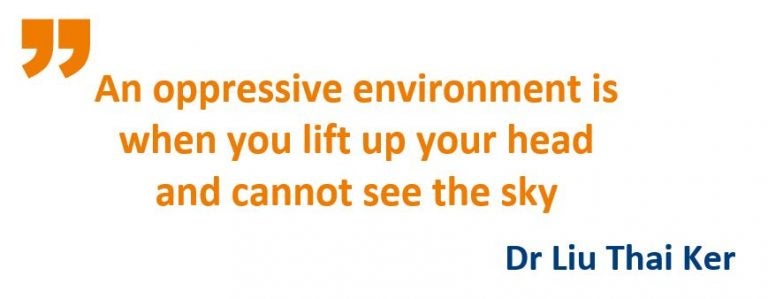Revisiting the fundamentals for the new normal
How can real estate frame a sustainable, long-term response to a virus that looks like it’s here to stay?
12 August 2021

As countries worldwide continue to grapple with Covid-19, with mutations emerging across different geographies, signs of the pandemic ending anytime soon remains remote. Indeed, as Professor Sing Tien Foo cautioned in his opening address of the 2021 Virtual Joint Real Estate Conference, “we may have to come to terms with Covid-19 as a permanent fixture in our lives, and learn to live with the virus”.
Professor Sing is the President of the Asian Real Estate Society (AsRES), which jointly organised the virtual conference together with the Global Chinese Real Estate Congress (GREC) and American Real Estate and Urban Economics Association (AREUEA).
“Today, the world is still fighting to contain Covid-19, and new variants of the virus add uncertainty on the path back to normalcy,” added Professor Sing, who is also Director at the Institute of Real Estate and Urban Studies and concurrently heads the Department of Real Estate at the National University of Singapore.

From left: Professor Sing Tien Foo, President of the Asian Real Estate Society (AsRES), who is also Director at the Institute of Real Estate and Urban Studies (IREUS) and concurrently heads the Department of Real Estate at the National University of Singapore; Associate Professor Yu Shi Ming, Department of Real Estate at the National University of Singapore and President of the Global Chinese Real Estate Congress (GREC).
Short-term reactions vs long-term solutions
Emergencies, by their tremendously disruptive and sometimes even life-threatening nature, require a swift and decisive response for damage control. Beyond the immediate reaction, however, policymakers and planners would need to examine the far-reaching ramifications of Covid-19, and their implications for an effective and sustainable response to bring society back on track to a new normal.
Thus the conference keynote speaker, Dr Cheong Koon Hean highlighted a three-pronged pandemic strategy comprising short-term interventions targeted at public health infrastructure, sanitation, water and air quality among others, then moving on to medium- and longer-term efforts to address broader issues of climate change, liveability, sustainability and social resilience.
Dr Cheong, a Professor of Practice at the Singapore University of Technology and Design (SUTD) who also chairs the Centre for Liveable Cities and Lee Kuan Yew Centre for Innovative Cities, noted optimistically that focus had begun to shift to medium term solutions, and set out a 7-point agenda to “build back better”.
What then are the pillars to build back better? What are the underlying principles that will inform methodologies, technologies and design considerations in urban planning and infrastructural development?
Revisiting the fundamentals – what do people really want?

From left: Dr Liu Thai Ker, Chairman, Morrow Architects & Planners; Dr Cheong Koon Hean, Chairman, Centre of Liveable Cities (MND) and Lee Kuan Yew Centre for Innovative Cities and Professor of Practice, Singapore University of Technology and Design; Mr Cheng Hsing Yao, CEO, GuocoLand Group; (Moderator) Dr Seek Ngee Huat, Chairman, Institute of Real Estate and Urban Studies and Chair’s Professor (Practice) of Real Estate at National University of Singapore; (On Zoom, not in picture) Professor Lam Khee Poh, Dean, School of Design and Environment at National University of Singapore.
In a plenary session based on the theme of “Planning for resilient and sustainable cities after Covid-19” moderated by Dr Seek Ngee Huat, Chairman of the Institute of Real Estate and Urban Studies and Chair’s Professor (Practice) of Real Estate at National University of Singapore (NUS), key ideas that surfaced include the human need for community and socialisation, as well as liveability in densely populated cities.
Mr Cheng Hsing Yao, CEO of Guocoland Group, highlighted that humans are by nature gregarious: socialisation and community inclusion are therefore fundamental considerations that ought to guide infrastructure development.
To him, the office of the new normal will be an enabler for building corporate culture, socialisation and mentorship, as well as cross-departmental, interdisciplinary collaboration and innovation. Citing Guoco Tower and Guoco Midtown as examples, Mr Cheng envisages the office of the future to radically expand beyond its functional purpose as a place to work to become a vibrant hub offering a holistic experience for its occupants to live, work and play in. Both Guoco Tower and Guoco Midtown offer ample communal space as well as lush greenery and beautiful landscaping.
Dr Liu Thai Ker, Chairman of Morrow Architects & Planners, likewise advocated a people-centric approach to urban planning. Recounting his time as the chief architect and chief executive of HDB, he shared that he had a team of sociologists with PhD degrees working together with architects, engineers and other subject matters experts to improve public housing in Singapore.
A “design thinking” approach therefore goes one more step beyond considerations of efficiency and cost-effectiveness to grapple with the question – “What do people really want?” – and an appropriate response to this question will be instrumental in fostering social resilience of sufficient calibre to weather Disease X and other “black swans”.
Liveability amid density

Between the summer of 1665 and the spring of 1667, the great physicist and mathematician Isaac Newton retreated to his countryside home to escape the bubonic “Great Plague” afflicting Cambridge and other urban areas in England.
Session moderator, Dr Seek noted that this time round, Covid-19 had similarly prompted an urban exodus in the West. According to the New York Times, city dwellers left, not only to avoid the virus, but also to “escape cramped and pricey apartments and to connect more with the natural world”.
In the context of land-scarce Singapore, how would the populace contend with this need for more space, asked Dr Seek?
Dr Liu added that 60% of the world’s population resides in Asia, which accounts for only 30% of the Earth’s land area, thus entailing high density in this geographical region. However, the doyen of architecture and urban planning expressed confidence in the ability of good and thoughtful design – through research and hard thinking – to compensate for the shortcomings of high density living.
Using the chessboard as an analogy, Dr Liu emphasised the need for amenities and recreational facilities such as parks and other communal spaces to be interspersed among dense residential blocks, much like how white squares break the monotony of black on the chess board. With the alternate usage of adjacent land parcels, public housing in Singapore has attracted attention and won accolades from the international community.
Along a similar vein, Professor Lam Khee Poh, Dean of the School of Design and Environment at NUS, urged planners and designers to be “cognizant of the environment”. He cautioned against over-reliance on technology such as air-conditioning, and, citing the NUS School of Design and Environment’s SDE4 building as an example, called for a return to climate-responsive design that leverages on natural ventilation and daylighting with ample views of the environment outside.
A pithy comment from Dr Liu aptly conveys a compelling message: “An oppressive environment is when you lift up your head and cannot see the sky.”

Building cities and communities that last
With outcomes defined, how then do we proceed? Amid multiple calls from various quarters to revamp cities, how do we sift through a cacophonous blanket of noise to dig out issues that really matter over the long run?
Reiterating his stance on the social dimension of urban development, Guocoland’s Mr Cheng advocated a 3P approach involving close collaboration among the government, private sector and the people. A broad collaborative approach is envisaged to build up social capital, which can not only help communities combat Covid-19, but also nurture a more resilient and sustainable future for society at large.
With regard to infrastructure, Dr Liu urges caution on throwing out the baby together with the bathwater in our haste to implement sweeping changes.
“Let us not be too hasty to say that because of the impact of the Covid-19 pandemic, (urban planners) should change the nature of cities or change the way we plan a city. Covid-19 is just a tiny part in the whole structure of city planning,” said Dr Liu.
“As a planner, we must try to implement long-term, intelligently conceived city plans with minimal changes to the basic urban systems as much as possible. Flexibility can come about through the modification of some minor urban fine tuning,” he continued.
Keynote speaker Dr Cheong added that future city planners would have to depart from a deterministic style to consider setting aside more land plots for flexible uses. “We would have to move from a more blueprint-like approach to flexible scenarios to plan for uncertainties,” she said.
Flexibility took the form of reserve land sites in development master plans during Singapore’s colonial years. Today, flexible land zoning is seen in the white sites set aside by the government.

